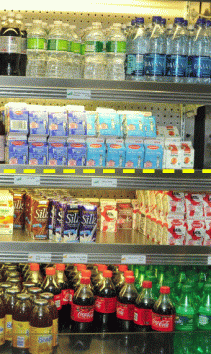 In my previous blog post, I discussed a study by Thorndike et al that looked at how both labeling healthy and unhealthy food choices with colour codes affected the purchase of healthy foods and beverages (1). The previous post focused on the “traffic light” labeling program, which created a new feedback loop that simplified the complexity of making healthy decision. Today I’ll look at the second phase of their experiment – choice architecture. Strategies that alter our environment to “nudge” people towards a desired choice can also serve to reduce the complexity of decision making. The results presented by Thorndike et al provide evidence to suggest that the simple rearrangement of the location of healthy food choices within a cafeteria can contribute to an increase consumer purchases of these options (1).
In my previous blog post, I discussed a study by Thorndike et al that looked at how both labeling healthy and unhealthy food choices with colour codes affected the purchase of healthy foods and beverages (1). The previous post focused on the “traffic light” labeling program, which created a new feedback loop that simplified the complexity of making healthy decision. Today I’ll look at the second phase of their experiment – choice architecture. Strategies that alter our environment to “nudge” people towards a desired choice can also serve to reduce the complexity of decision making. The results presented by Thorndike et al provide evidence to suggest that the simple rearrangement of the location of healthy food choices within a cafeteria can contribute to an increase consumer purchases of these options (1).
Choice architecture refers to how our environment is designed to influence the choices we make. In the study by Thorndike et al, healthy items (those with a green coded label) were placed at eye level in coolers throughout the cafeteria. Additionally, bottled water was placed in displays in new locations – all with the goal of increasing visibility. Is it simply enough to make a healthy choice more visible to get people to choose it? The study found that yes, at least for beverages, placing healthy choices more prominently throughout the cafeteria led to an increase in sales of those items. Bottled water sales increased 25.8% during the second phase of the study.
According to Richard Thaler (2), there are three basic principles of choice architecture. First, establish desirable defaults. Defaults refer to the the path of least resistance. Next expect errors; or design with the acknowledgement that humans make mistakes. And third, give feedback.
How can we leverage these principles to effectively nudge people towards healthier behaviours? Some interventions, such as studied by Thorndike et al have begun by modifying the defaults. The Smarter Lunchrooms Movement is another initiative with similar goals in schools across the US. Reducing the size of bowls in the lunch room, an example of changing the default, led to students serving smaller portions of cereal at breakfast. Similarly, putting chocolate milk behind the plain milk increases the difficulty of getting chocolate milk and led to an increase in the amount of plain milk sold over chocolate milk. Moving baskets of fresh fruit next to the cashiers in school cafeteria also led to an increase in their sales(3).
Can the concepts of nudges be taken beyond the school lunch room? In an upcoming post I’ll take a look at the UK Behavioural Insights Teams and the opposing views on its potential for success.
References:
![]() 1. Thorndike, A., Sonnenberg, L., Riis, J., Barraclough, S., & Levy, D. (2012). A 2-Phase Labeling and Choice Architecture Intervention to Improve Healthy Food and Beverage Choices American Journal of Public Health DOI: 10.2105/AJPH.2011.300391
1. Thorndike, A., Sonnenberg, L., Riis, J., Barraclough, S., & Levy, D. (2012). A 2-Phase Labeling and Choice Architecture Intervention to Improve Healthy Food and Beverage Choices American Journal of Public Health DOI: 10.2105/AJPH.2011.300391
2. Thaler, R. and C. Sunstein. (2008) Nudge: Improving Decisions about Health, Wealth and Happiness. Yale University Press. New Haven and London.
3. Just, D.R. and B. Wansink (2009) Smarter Lunchrooms: Using Behavioral Economics to Improve Meal Selection. Choices 24(3)
Related readings:
- Behavioural Economics – a way to fight Big Food from Verdant Nation
- Google’s Impressive Healthy Food Program from Marion Nestle on Food Politics
- Opting In versus Opting Out by Richard Thaler

